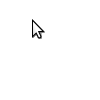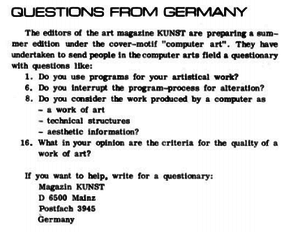User:Joak/mediaobject: Difference between revisions
No edit summary |
No edit summary |
||
| Line 20: | Line 20: | ||
margin-left: auto; | margin-left: auto; | ||
margin-right: auto"> | margin-right: auto"> | ||
In 1970 the editor of German magazine "Kunst" announced in PAGE #9 (the bulletin of the computer arts society)<ref name="page">PAGE #9 July 1970, p. 3, Available from http://www.bbk.ac.uk/hosted/cache/archive/PAGE/PAGE9.pdf</ref>, that they will publish there next edition under the cover-motif "computer art". In a questionary for computer artist the sixth question asked is "Do you interrupt the program-process for alteration?". It is hard to understand if we compare those old computers with this slick almost invisible machines on our desks nowadays! To retrace this question it's necessary to keep in mind the technological circumstances. At this time computer where executing programs from the beginning to the end. Once the machine was running a program the only possibility to stop it was to switch of the power. | In 1970 the editor of German magazine "Kunst" announced in PAGE #9 (the bulletin of the computer arts society)<ref name="page">PAGE #9 July 1970, p. 3, Available from http://www.bbk.ac.uk/hosted/cache/archive/PAGE/PAGE9.pdf</ref>, that they will publish there next edition under the cover-motif "computer art". In a questionary for computer artist the sixth question asked is "Do you interrupt the program-process for alteration?". It is hard to understand if we compare those old computers with this slick almost invisible machines on our desks nowadays! To retrace this question it's necessary to keep in mind the technological circumstances. At this time computer where executing programs from the beginning to the end. Once the machine was running a program the only possibility to stop it was to switch of the power. </p> | ||
<br> | <br> | ||
<h3 style=" | <h3 style=" | ||
| Line 31: | Line 31: | ||
margin-left: auto; | margin-left: auto; | ||
margin-right: auto"> | margin-right: auto"> | ||
interrupt</h3> | |||
<h3 style=" | |||
color:black; | |||
margin-left:0px; | |||
font-family:times; | |||
letter-spacing:1px; | |||
width:600px; | |||
text-align:center; | |||
margin-left: auto; | |||
margin-right: auto"> | |||
mouse</h3> | |||
<p style=" | <p style=" | ||
color:black; | color:black; | ||
| Line 43: | Line 53: | ||
The mouse is commonly known as an interface for computers. It is used by the users hand, thereby the object 'mouse' got its shape by the negativ form of the users hand. In generic designs there are two buttons attached under the forefinger and the middle finger of the user. The hands motion is translates by the device into electronic signals and normally represented on the monitor by a small pointer. The invention mouse is connected to the name Douglas Engelbart who applied in 1967 for patent called "X-y position indicator for a display system"[4]. Before Engelbart a similar system called "trackball" was used for military purpose, but on a wide scale the mouse was introduced in 1972 with the "Xero Alto" one of the first personal computers and the first computer that used the concept of the desktop metaphor<ref name="xerox">ALTO: A Personal Computer System Hardware Manual August 1976 Available from http://bitsavers.informatik.uni-stuttgart.de/pdf/xerox/alto/Alto_Hardware_Manual_Aug76.pdf</ref>. | The mouse is commonly known as an interface for computers. It is used by the users hand, thereby the object 'mouse' got its shape by the negativ form of the users hand. In generic designs there are two buttons attached under the forefinger and the middle finger of the user. The hands motion is translates by the device into electronic signals and normally represented on the monitor by a small pointer. The invention mouse is connected to the name Douglas Engelbart who applied in 1967 for patent called "X-y position indicator for a display system"[4]. Before Engelbart a similar system called "trackball" was used for military purpose, but on a wide scale the mouse was introduced in 1972 with the "Xero Alto" one of the first personal computers and the first computer that used the concept of the desktop metaphor<ref name="xerox">ALTO: A Personal Computer System Hardware Manual August 1976 Available from http://bitsavers.informatik.uni-stuttgart.de/pdf/xerox/alto/Alto_Hardware_Manual_Aug76.pdf</ref>. | ||
</p> | </p> | ||
<h3 style=" | |||
color:black; | |||
margin-left:0px; | |||
font-family:times; | |||
letter-spacing:1px; | |||
width:600px; | |||
text-align:center; | |||
margin-left: auto; | |||
margin-right: auto"> | |||
the mouse interrupting the xerox alto</h3> | |||
* -> example interrupt xero alto | * -> example interrupt xero alto | ||
* -> explaine mouse and the interrupt | * -> explaine mouse and the interrupt | ||
<ol style=" | <ol style=" | ||
color:black; | color:black; | ||
Revision as of 22:19, 14 October 2014
the mouse and the interrupt
In 1970 the editor of German magazine "Kunst" announced in PAGE #9 (the bulletin of the computer arts society)[1], that they will publish there next edition under the cover-motif "computer art". In a questionary for computer artist the sixth question asked is "Do you interrupt the program-process for alteration?". It is hard to understand if we compare those old computers with this slick almost invisible machines on our desks nowadays! To retrace this question it's necessary to keep in mind the technological circumstances. At this time computer where executing programs from the beginning to the end. Once the machine was running a program the only possibility to stop it was to switch of the power.
interrupt
mouse
The mouse is commonly known as an interface for computers. It is used by the users hand, thereby the object 'mouse' got its shape by the negativ form of the users hand. In generic designs there are two buttons attached under the forefinger and the middle finger of the user. The hands motion is translates by the device into electronic signals and normally represented on the monitor by a small pointer. The invention mouse is connected to the name Douglas Engelbart who applied in 1967 for patent called "X-y position indicator for a display system"[4]. Before Engelbart a similar system called "trackball" was used for military purpose, but on a wide scale the mouse was introduced in 1972 with the "Xero Alto" one of the first personal computers and the first computer that used the concept of the desktop metaphor[2].
the mouse interrupting the xerox alto
- -> example interrupt xero alto
- -> explaine mouse and the interrupt
-
<references>
==== see ====:
- [1] PAGE #9
- [2] Interrupt by Simon Yull, Originally published in Matthew Fuller (ed.), Software Studies: A Lexicon,
Cambridge, Massachusetts, London, England: The MIT Press, 2008. ./interrupt.pdf
- [3]The Social Construction of Technological Systems: New Directions in the Sociology and History of Technology (1987)
- [4] patent engelbart
- [5]manuel xero alto
- ↑ PAGE #9 July 1970, p. 3, Available from http://www.bbk.ac.uk/hosted/cache/archive/PAGE/PAGE9.pdf
- ↑ ALTO: A Personal Computer System Hardware Manual August 1976 Available from http://bitsavers.informatik.uni-stuttgart.de/pdf/xerox/alto/Alto_Hardware_Manual_Aug76.pdf


